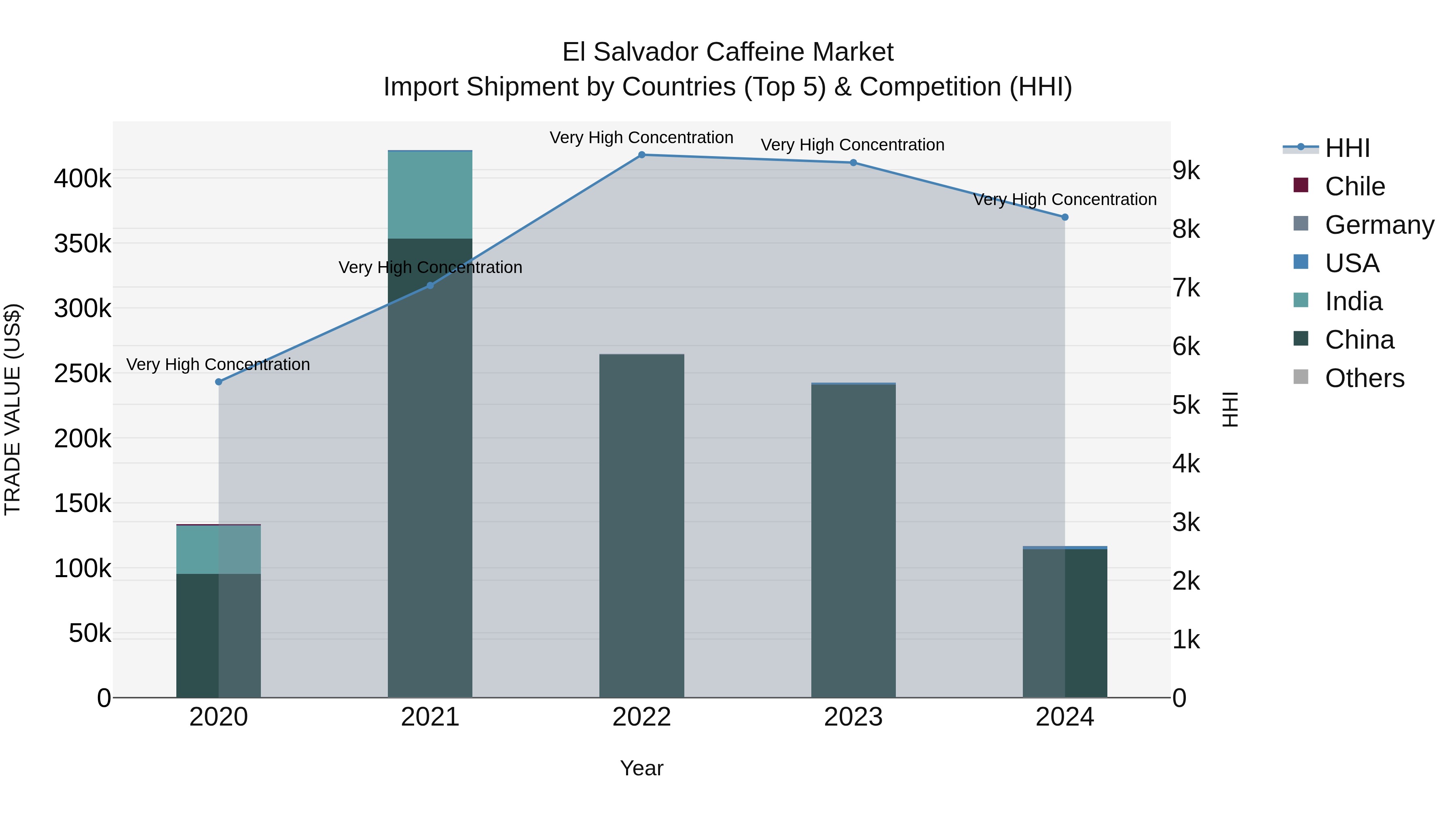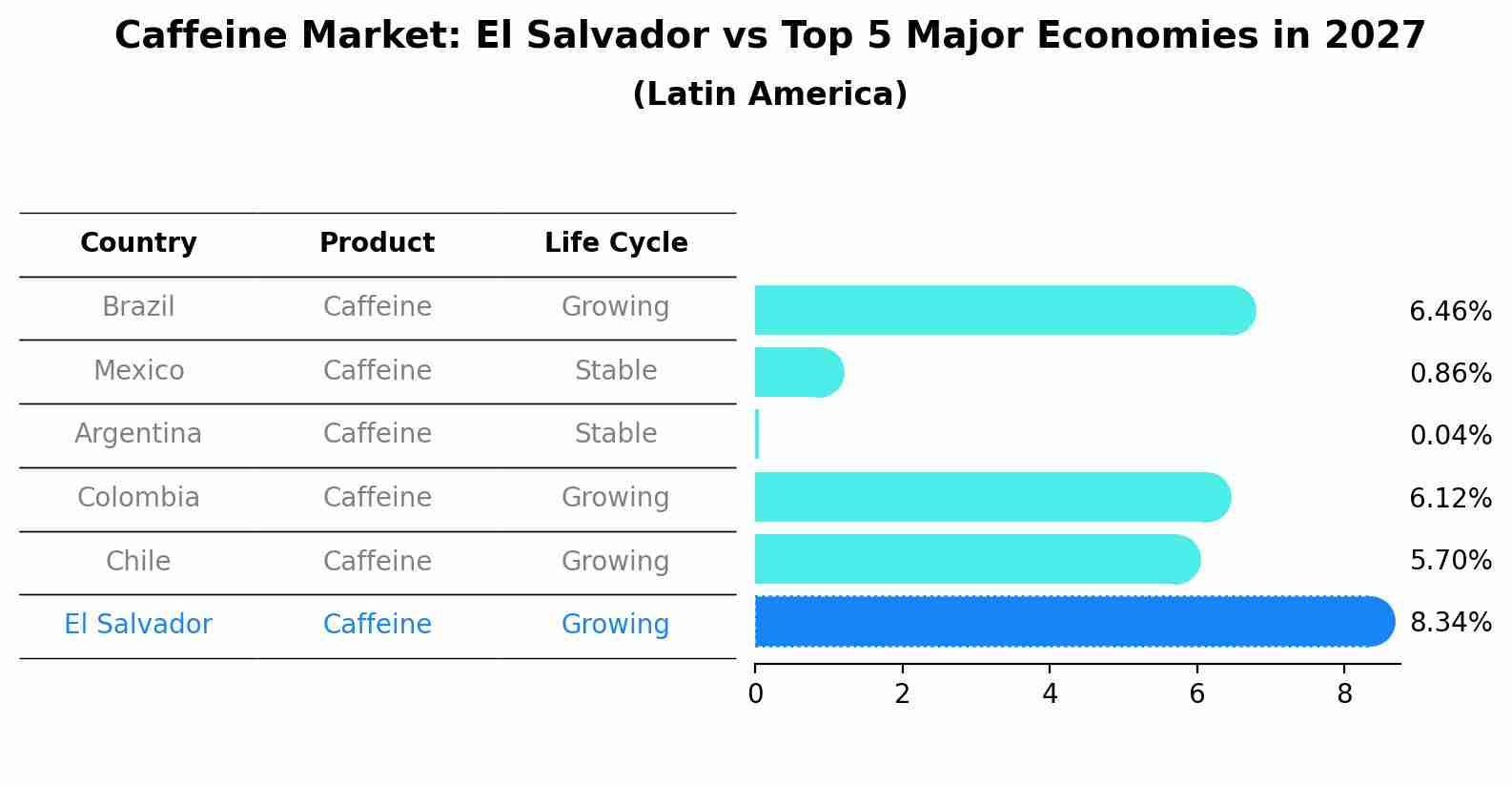El Salvador Caffeine Market (2025-2031) | Outlook, Industry, Growth, Analysis, Share, Value, Trends, Companies, Segmentation, Revenue, Size & Forecast
| Product Code: ETC4741745 | Publication Date: Nov 2023 | Updated Date: Nov 2025 | Product Type: Market Research Report | |
| Publisher: 6Wresearch | Author: Shubham Deep | No. of Pages: 60 | No. of Figures: 30 | No. of Tables: 5 |
El Salvador Caffeine Market Top 5 Importing Countries and Market Competition (HHI) Analysis
In 2024, El Salvador continued to see significant caffeine import shipments from key countries such as China, USA, Canada, Germany, and India. Despite a negative compound annual growth rate (CAGR) of -3.35% from 2020 to 2024 and a steep decline in growth rate from 2023 to 2024 (-51.94%), the market remained highly concentrated with a high Herfindahl-Hirschman Index (HHI). This indicates a competitive landscape dominated by a few major players. It will be crucial for stakeholders to monitor shifting trends and adapt strategies to navigate the challenging market conditions.

Caffeine Market: El Salvador vs Top 5 Major Economies in 2027 (Latin America)
The Caffeine market in El Salvador is projected to grow at a growing growth rate of 8.34% by 2027, within the Latin America region led by Brazil, along with other countries like Mexico, Argentina, Colombia and Chile, collectively shaping a dynamic and evolving market environment driven by innovation and increasing adoption of emerging technologies.

El Salvador Caffeine Market Overview
The caffeine market in El Salvador is growing due to the increasing consumption of caffeinated beverages like coffee, energy drinks, and soft drinks. As coffee remains a cultural staple in Central America, El Salvador`s demand for caffeine as a key ingredient in its beverage industry is strong. Additionally, the market for caffeine in pharmaceuticals and dietary supplements is also seeing growth.
Drivers of the market
The caffeine market in El Salvador is primarily driven by the popularity of coffee, as the country is known for its rich coffee culture and production. Caffeine is a key component in coffee, and as coffee consumption continues to grow locally and globally, the demand for caffeine remains high. Additionally, caffeine is used in energy drinks, soft drinks, and dietary supplements, which are becoming increasingly popular in El Salvador as consumers seek energy-boosting products. The countrys coffee export industry also plays a significant role in driving the caffeine market, as Salvadoran coffee is renowned internationally for its quality and flavor.
Challenges of the market
The El Salvador Caffeine Market faces challenges related to the increasing competition from other stimulant products, including energy drinks and supplements, which offer higher concentrations of caffeine and often target a younger demographic. Additionally, while coffee production is a significant part of the country`s economy, there is limited value-added processing within El Salvador. This means the local market often relies on international brands for processed caffeine products, limiting growth opportunities for domestic producers. The regulatory environment around caffeine consumption and marketing is another challenge, as there are increasing concerns about health risks associated with excessive caffeine intake, leading to stricter regulations that can impact market growth.
Government Policy of the market
El Salvador`s government plays a crucial role in the regulation of the caffeine market, primarily through policies supporting the local coffee industry. As one of Central Americas top coffee producers, El Salvadors government has implemented measures to promote sustainable farming practices, improve coffee quality, and enhance export opportunities. Additionally, there are food safety and health regulations in place to control caffeine content in various products, ensuring consumer safety while fostering the markets growth.
Key Highlights of the Report:
- El Salvador Caffeine Market Outlook
- Market Size of El Salvador Caffeine Market, 2024
- Forecast of El Salvador Caffeine Market, 2031
- Historical Data and Forecast of El Salvador Caffeine Revenues & Volume for the Period 2021-2031
- El Salvador Caffeine Market Trend Evolution
- El Salvador Caffeine Market Drivers and Challenges
- El Salvador Caffeine Price Trends
- El Salvador Caffeine Porter`s Five Forces
- El Salvador Caffeine Industry Life Cycle
- Historical Data and Forecast of El Salvador Caffeine Market Revenues & Volume By Type for the Period 2021-2031
- Historical Data and Forecast of El Salvador Caffeine Market Revenues & Volume By Natural Caffeine for the Period 2021-2031
- Historical Data and Forecast of El Salvador Caffeine Market Revenues & Volume By Synthetic Caffeine for the Period 2021-2031
- Historical Data and Forecast of El Salvador Caffeine Market Revenues & Volume By Applications for the Period 2021-2031
- Historical Data and Forecast of El Salvador Caffeine Market Revenues & Volume By Pharmaceuticals for the Period 2021-2031
- Historical Data and Forecast of El Salvador Caffeine Market Revenues & Volume By Food for the Period 2021-2031
- Historical Data and Forecast of El Salvador Caffeine Market Revenues & Volume By Beverages for the Period 2021-2031
- Historical Data and Forecast of El Salvador Caffeine Market Revenues & Volume By Flavors and Fragrances for the Period 2021-2031
- El Salvador Caffeine Import Export Trade Statistics
- Market Opportunity Assessment By Type
- Market Opportunity Assessment By Applications
- El Salvador Caffeine Top Companies Market Share
- El Salvador Caffeine Competitive Benchmarking By Technical and Operational Parameters
- El Salvador Caffeine Company Profiles
- El Salvador Caffeine Key Strategic Recommendations
Frequently Asked Questions About the Market Study (FAQs):
1 Executive Summary |
2 Introduction |
2.1 Key Highlights of the Report |
2.2 Report Description |
2.3 Market Scope & Segmentation |
2.4 Research Methodology |
2.5 Assumptions |
3 El Salvador Caffeine Market Overview |
3.1 El Salvador Country Macro Economic Indicators |
3.2 El Salvador Caffeine Market Revenues & Volume, 2021 & 2031F |
3.3 El Salvador Caffeine Market - Industry Life Cycle |
3.4 El Salvador Caffeine Market - Porter's Five Forces |
3.5 El Salvador Caffeine Market Revenues & Volume Share, By Type, 2021 & 2031F |
3.6 El Salvador Caffeine Market Revenues & Volume Share, By Applications, 2021 & 2031F |
4 El Salvador Caffeine Market Dynamics |
4.1 Impact Analysis |
4.2 Market Drivers |
4.3 Market Restraints |
5 El Salvador Caffeine Market Trends |
6 El Salvador Caffeine Market Segmentations |
6.1 El Salvador Caffeine Market, By Type |
6.1.1 Overview and Analysis |
6.1.2 El Salvador Caffeine Market Revenues & Volume, By Natural Caffeine, 2021-2031F |
6.1.3 El Salvador Caffeine Market Revenues & Volume, By Synthetic Caffeine, 2021-2031F |
6.2 El Salvador Caffeine Market, By Applications |
6.2.1 Overview and Analysis |
6.2.2 El Salvador Caffeine Market Revenues & Volume, By Pharmaceuticals, 2021-2031F |
6.2.3 El Salvador Caffeine Market Revenues & Volume, By Food, 2021-2031F |
6.2.4 El Salvador Caffeine Market Revenues & Volume, By Beverages, 2021-2031F |
6.2.5 El Salvador Caffeine Market Revenues & Volume, By Flavors and Fragrances, 2021-2031F |
7 El Salvador Caffeine Market Import-Export Trade Statistics |
7.1 El Salvador Caffeine Market Export to Major Countries |
7.2 El Salvador Caffeine Market Imports from Major Countries |
8 El Salvador Caffeine Market Key Performance Indicators |
9 El Salvador Caffeine Market - Opportunity Assessment |
9.1 El Salvador Caffeine Market Opportunity Assessment, By Type, 2021 & 2031F |
9.2 El Salvador Caffeine Market Opportunity Assessment, By Applications, 2021 & 2031F |
10 El Salvador Caffeine Market - Competitive Landscape |
10.1 El Salvador Caffeine Market Revenue Share, By Companies, 2024 |
10.2 El Salvador Caffeine Market Competitive Benchmarking, By Operating and Technical Parameters |
11 Company Profiles |
12 Recommendations | 13 Disclaimer |
- Single User License$ 1,995
- Department License$ 2,400
- Site License$ 3,120
- Global License$ 3,795
Search
Thought Leadership and Analyst Meet
Our Clients
Related Reports
- Afghanistan Apparel Market (2026-2032) | Growth, Outlook, Industry, Segmentation, Forecast, Size, Companies, Trends, Value, Share, Analysis & Revenue
- Canada Oil and Gas Market (2026-2032) | Share, Segmentation, Value, Industry, Trends, Forecast, Analysis, Size & Revenue, Growth, Competitive Landscape, Outlook, Companies
- Germany Breakfast Food Market (2026-2032) | Industry, Share, Growth, Size, Companies, Value, Analysis, Revenue, Trends, Forecast & Outlook
- Australia Briquette Market (2025-2031) | Growth, Size, Revenue, Forecast, Analysis, Trends, Value, Share, Industry & Companies
- Vietnam System Integrator Market (2025-2031) | Size, Companies, Analysis, Industry, Value, Forecast, Growth, Trends, Revenue & Share
- ASEAN and Thailand Brain Health Supplements Market (2025-2031) | Strategy, Consumer Insights, Analysis, Investment Trends, Opportunities, Growth, Size, Share, Industry, Revenue, Segments, Value, Segmentation, Supply, Forecast, Restraints, Outlook, Competition, Drivers, Trends, Demand, Pricing Analysis, Competitive, Strategic Insights, Companies, Challenges
- ASEAN Bearings Market (2025-2031) | Strategy, Consumer Insights, Analysis, Investment Trends, Opportunities, Growth, Size, Share, Industry, Revenue, Segments, Value, Segmentation, Supply, Forecast, Restraints, Outlook, Competition, Drivers, Trends, Demand, Pricing Analysis, Competitive, Strategic Insights, Companies, Challenges
- Europe Flooring Market (2025-2031) | Outlook, Share, Industry, Trends, Forecast, Companies, Revenue, Size, Analysis, Growth & Value
- Saudi Arabia Manlift Market (2025-2031) | Outlook, Size, Growth, Trends, Companies, Industry, Revenue, Value, Share, Forecast & Analysis
- Uganda Excavator, Crane, and Wheel Loaders Market (2025-2031) | Strategy, Consumer Insights, Analysis, Investment Trends, Opportunities, Growth, Size, Share, Industry, Revenue, Segments, Value, Segmentation, Supply, Forecast, Restraints, Outlook, Competition, Drivers, Trends, Demand, Pricing Analysis, Competitive, Strategic Insights, Companies, Challenges
Industry Events and Analyst Meet
Whitepaper
- Middle East & Africa Commercial Security Market Click here to view more.
- Middle East & Africa Fire Safety Systems & Equipment Market Click here to view more.
- GCC Drone Market Click here to view more.
- Middle East Lighting Fixture Market Click here to view more.
- GCC Physical & Perimeter Security Market Click here to view more.
6WResearch In News
- Doha a strategic location for EV manufacturing hub: IPA Qatar
- Demand for luxury TVs surging in the GCC, says Samsung
- Empowering Growth: The Thriving Journey of Bangladesh’s Cable Industry
- Demand for luxury TVs surging in the GCC, says Samsung
- Video call with a traditional healer? Once unthinkable, it’s now common in South Africa
- Intelligent Buildings To Smooth GCC’s Path To Net Zero


















